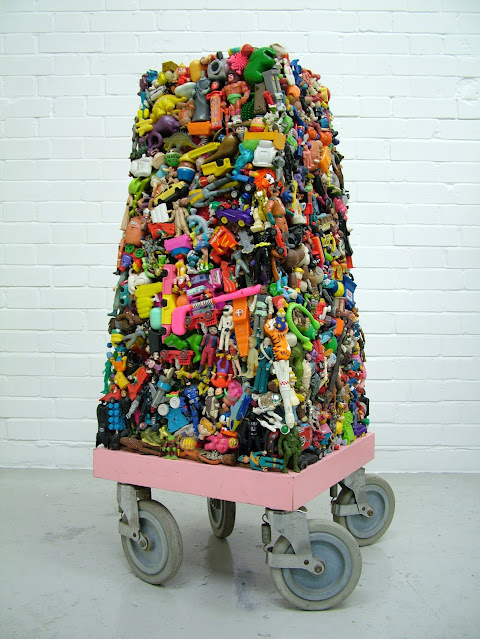Regardless of what
my ego might want to believe I always have more than one foot in the 'don't
believe the hype' camp. However, it is still rather lovely to have had my work
featured in the Nokia Connects article 'Junk Rock! The 7 Greatest Upcycled Artworks Ever',
alongside works by such greats as Duchamp, Picasso, Tim Noble & Sue Webster,
Erika Iris Simmons, Seo Young-Deok and Thomas Allen. The article was written by
the talented writer/photographer Adam Monaghan and featured my Magnet sculpture,
which is now in the permanent collection of the Black Gold Museum in Riyadh,
Saudi Arabia.
The article was
published quite some time ago and even though I featured a link to it in a
previous blog post, the original piece sadly went the way of many online
articles and disappeared from the internet. Fortunately I managed to find the
original text and have decided to repost it here. I don't recall the exact
photos used in the original article so I've made my own selection of artwork
images by the featured artists, and presented them here.
Junk rock! The 7 greatest upcycled artworks
ever
In our environmentally concerned world it is perhaps not surprising to find art works made of ‘junk’, ‘scrap’ or ‘re-used’ products. And as recycling has, quite rightly, become a normal part of life rather than a weird niche activity, artists too have embraced pre-owned objects.
But art and scrap have a long history. So here’s a couple of recycled classics and a few new additions, which we think warrant a place on the all-time list of the greatest
upcycled artworks ever.
Marcel Duchamp
Back in 1913,
Marcel Duchamp changed the art world forever. He began working on the idea of ‘
Readymades’ – objects selected from the world rather than actually made by an artist. Having it’s antecedents in
Dada and the notion of ‘
anti-art’ Duchamp’s work was often tinged with humour, such as the snow shovel entitled ‘
In Advance of the Broken Arm’ (1915). His work, ‘
Fountain’ (1917) is perhaps the most famous ‘Readymade’: a normal, everyday urinal, signed ‘R.Mutt’ and turned upside down.
Pablo Picasso
Turning junk into art and out-Duchamping-Duchamp in one fail swoop. Picasso’s ‘
Bull’s Head’ (1942) is a masterfully simple juxtaposition. Its brilliance lies partially in the fact that it is instantaneously and simultaneously recognisable as both bike saddle and handlebars and as a bull’s head.
Picasso’s residency in Paris throughout World War II was of great moral and symbolic significance. And this work should not only be seen as art world one-upmanship but as brave (and also humorous) defiance of the Occupation.
Tim Noble and Sue Webster
Rising to stardom on the tide of the thriving British art scene in the mid-1990s,
Tim Noble and Sue Webster turn rubbish into something elegant and ingenious. In a typical shadow work, a single light source illuminates the seemingly random pile of rubbish and casts a perfect silhouette of the artists on the wall behind. The rubbish itself is often linked to the artists, such as in ‘
Dirty White Trash (with Gulls)’ (1998), which is sculpted out of six months of the artists’ domestic waste. Funny, poignant and surprising… what more could you ask for?
Wayne Chisnall
Wayne Chisnall is one of those annoying artists who seems at home in whichever medium he chooses to work in, from stunning draughtsmanship to witty sculptures. A great deal of Chisnall’s work uses found materials, be it wood, books, dissembled scientific equipment or discarded toys. An ever expanding list of impressive exhibitions and a growing presence on the London art scene means Chisnall is certainly one to keep an eye on over the next few years.
Erika Iris Simmons
Erika Iris Simmons specialises in recycling old books, cassettes, playing cards and magazines. Her popular series, ‘Ghost in the Machine’, features portraits of musicians made from old cassette tapes. Simmons says of her work, “I don’t really add any paint or pigments… I usually just take things apart and re-arrange the pieces, cutting away portions when necessary… One day as I was leaving to go to work I saw a pile of cassette tapes laying on top of a canvas I had set near my door. I thought, “What ghosts could be hiding in those machines?” I pulled out the ribbon and tried to work with it, making some writing. I watched the ribbon curl up and it reminded me of Jimi Hendrix’s crazy hair, so that was the first portrait I made.”
Seo Young-Deok
Korean artist
Seo Young-Deok is a sculptor who graduated from the Environmental Sculpture programme at the University of Seoul. His works are made from – literally – miles of bicycle chains, carefully welded together to crate bodily forms and heads. His large sculpted head, which stands over two metres tall took over a year to build and is made of both recycled and new bike chains. Seo Young-Deok says that he finds inspiration in many places, from construction sites to the bustling Korean markets to traditional Buddhist sculptures.
Thomas Allen
To be honest,
Thomas Allen is quite simply one of my favourite artists. Upon first seeing his work, I was completely taken aback and immediately in love with them. Funny, clever, cheeky and perfectly constructed; they stood out in an art world full of tired and unoriginal ideas and dull conceptualism run wild. By carefully cutting out the figures from pulp novels of the 1940s and 50s, then expertly lighting and re-photographing them, Allen has given these books and their implied narratives a new lease of life. A simple idea that simply works perfectly.















%20-%20Copy.jpg)

.jpg)
.JPG)
.jpg)
.jpg)
.jpg)
.jpg)

.jpg)
.jpg)
.jpg)

.jpg)


.jpg)





.jpg)
.jpg)
.jpg)
.jpg)
.jpg)

.jpg)